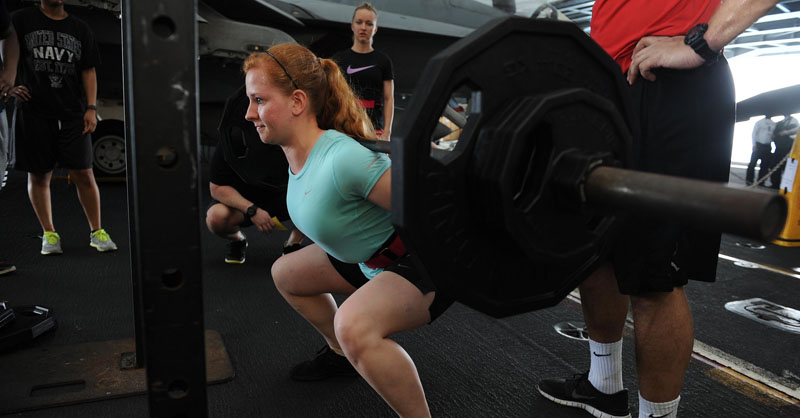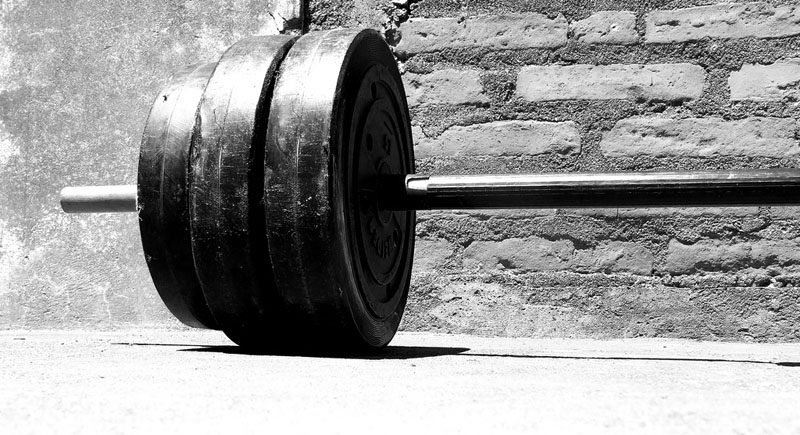Workout plans are a dime-a-dozen on the internet, and you need one that is not only effective but one that you can stick to for the long term. And this is true regardless of whether you want to build muscle, lose fat, do a little bit of both or just get stronger.
There’s a lot that goes into deciding what type of workout plan is best for you, and when you understand how a training program is put together, it’s easier to make a decision on which program will be best for you.
In this article, we’re going to cover training frequency, schedule preferences, fat loss and muscle gain goals, and I’ll give program options as we go.
NOTE: please keep in mind it’s impossible to detail every single type of training program or protocol on one article. There are thousands of books written on the subject. I’m merely giving you what I think are some of the best workout plans for building muscle, losing fat and building an aesthetic physique.
Determining Training Frequency For Your Workout Plans
Training frequency typically means how often you’re training during the week. However, this can have a few meanings depending on how you look at it, so let’s do that.
Training Frequency:
- how often you go to the gym
- how often you train each body part / muscle group
For instance, the classic body-part split programs will have you training each body part once per week, so if you want to hit your entire body equally over a seven day period, you might be required to have five to six sessions in seven days.
But you could hit your entire body twice in seven days by following an upper/lower split.
And you can also hit every muscle group three times by doing a full-body program over three days per week.
The main thing to understand is this: many training programs can and will work but it has to fit in with your schedule. Your availability is the ultimate determinant of how often you can and will realistically be able train.
Second to that is your level of dedication, and how lofty your goals are. Your goals may determine your availability if they’re a major priority.
Everyone’s schedule is different, and therefore, understanding the types of training splits available is important when determining how you plan to build your physique.
According to the science (the limited amount we have, anyway) on training frequency, we understand that the likely optimal frequency is training each body part two to three times per week, and this is mostly due to what we know about muscle protein synthesis.
Now this is a loaded statement because there are a thousand and one variables that will determine how frequently or infrequently you’re training.
Not even the best PubMed Science is going to reveal what’s optimal, because in the case of studying 20 people ala this study, you (as an individual) might need more or less of a stimulus depending on way too many factors to list.
You could train six days per week and utilize a frequency of hitting your entire body directly once over seven days (targeting only a few muscle groups per day), or you could hit each muscle group three to six times during the week depending on your training split.
Remember this: there is no single right or wrong way to train. There are benefits from training with heavy loads, light loads, very frequently, infrequently, and all the variables in between.
Most people will benefit from cycling their training over the course of a year – altering their frequency, intensities, and loads.
We do this automatically with HOT BOD, my women’s program.

An example of this is training mostly for strength for twelve weeks followed by eight weeks of more conditioning-based training, supersetting, and dare I say it, even more bodybuilding style workouts.
The body is very good at adapting to the loads and stimulus over time, so it does make sense to push the limits using one program for eight to twelve weeks and then changing your routine to induce a new stimulus.
All the best bodies were built this way, and if you want the best results, you’re no exception to the rule.
Workout Plans + Training Frequencies

Below are some sample workout plan ideas to determine how one might train their body based on how many days they have in their schedule for the gym.
Note: please keep in mind these methods are not the only way to train for the given availability.
2 Days Per Week:
Possible Training Methods:
- Full Body Training Split
- Upper/Lower Training Split
With full body training, like it sounds, you would train the entire body every session. A good way to accomplish this is to focus on three main compound movements, and three accessory movements. This will be covered in full in the Training Split and Sample Program section.
If you opted for an upper/lower set-up, then you’d train the upper body one session and the lower body another session, hitting the full body over the course of the week.
3 Days Per Week:
When training three days per week, your options open up more than the two-days-per-week version. I personally prefer full body and upper lower split routines when you have three days available to train.
Possible Training Methods:
- Full Body Training Split (full body training every session)
- Upper/Lower Training Split (alternating upper/lower training every other day)
- Push/Pull/Legs
- Body part emphasis like my booty band workout
4 Days Per Week:
When training four days per week, you can really start to experiment with frequency, and volume. The clue here is to understand where you’re at and where you want to take your physique.
For the most part, any of the splits below will work well but it’s up to you or your coach to make the call on what’s best for you now.
Possible Training Methods:
- Upper/Lower Split
- Upper/Lower Body Part Emphasis Split
- Body part split
- Daily Undulating Periodization
5 Days Per Week:
When you have the option of training five days per week, creativity can be your best friend when dealing with training splits. Some like to focus on strength work early in the week, and then do more bodybuilding type of training later in the week.
Some will even opt for a mix of weight training and bodyweight training for recovery purposes.
Possible Training Methods:
- Upper/Lower Split with a day for lagging body parts
- Upper/Lower Body Part Emphasis Split with a day for lagging body parts
- Upper/Lower Split with strength-specific training early in the week, three day bodybuilding split later in the week
- Body part split
- Daily Undulating Periodization
What’s Your Main Goal?
There are typically three main goals people have when it comes to choosing the right workout plan for them. Those goals are one or a combination of the following:
- Fat Loss
- Muscle Gain
- Strength Gain
With all good workout plans and training programs, one thing is clear: you should be able to gain strength consistently.
The only caveat here is if you’re a very advanced trainee, you likely won’t be able to get stronger in a calculated fashion.
When you’re near the upper genetic limits of strength levels, adding just one pound or one rep to your lifts can seem impossible.
Regardless of the goal (fat loss or muscle gain), your program should allow for improvements, either in total weight lifted or by improving your rep totals.
The long term focus for building a better physique is twofold: progressive overload, and time under the bar (experience).
If you don’t get stronger progressively and don’t gain the experience of training over time, then it’s nearly impossible to have the physique of someone who’s done all the right things.
So let’s break down the goals and how the training should look for each of them.
Training For Fat Loss
When you’re focusing on fat loss, two ideas should always be kept in mind:
- You have limited recovery ability due to the caloric deficit (less food).
- Your workout plan should not inhibit performance a great deal. It should be just enough to bounce back from (recovery is crucial) on a regular basis.
Training for fat loss can be done in many ways. You can train two days or six days and still get great results. The trick is in balancing the training and diet stress with the rest of your life.
Most people with normal lives and regular jobs don’t have a ton of extra time to spend in the gym.
So while some can make it to the gym every single day for an hour or longer, others might only have three hours per week for regular weight training.
Regardless of where you fall on the spectrum of schedule availability, there’s always a solution. And when you’re determining that solution, it must fit in with your schedule so you’re sure to stick with it.
You can successfully lose fat training two or six days per week. The program and frequency you choose will be based on your availability, stress load and preferences.
Remember: consistency with your program will trump almost every other variable because even following a slightly less optimal program regularly will yield far better results than casually following a more demanding, more advanced program.
When training for fat loss, focus should be placed on the following variables:
- Training: Program is built upon the compound lifts emphasizing progressive overload.
- Nutrition: Consuming enough protein, carbs and fat to fuel activity, but create a slight deficit.
- Recovery: Getting enough rest and downtime to rebuild and repair.
SIDE NOTE: here at JCD Fitness, we don’t recommend training more than four times per week when the goal is fat loss. Recovery is going to be hindered as a result of the caloric deficit and it’s very easy to dig yourself into a hole very quickly if your training is challenging.
Training For Muscle Gain

When you’re training for hypertrophy (aka muscle gain), recovery ability and a tolerance for higher intensities can open up for the majority of people. Here’s why:
- More food = better recovery.
- Can be advantageous to train more frequently due to Muscle Protein Synthesis.
When one is training specifically for muscle gain, the act of eating more food will greatly impact their ability to train more often and with higher intensity.
More food is more energy to both fuel the training and to provide the nutrients necessary to utilize, not only the repair but the rebuilding (and then some) of the muscle and connective tissues.
Since this is NOT an article on nutrition, you can check this one about how much protein you need, and I’ll eventually cover eating for muscle growth and fat loss in upcoming articles.
But to talk about training specifically for muscle gain, here’s the rub: programs with a training frequency of two to six times per week can and do work. The trick is in moderating the loads to ensure you can recover from the training without being annihilated by it.
Some research suggests that due to Muscle Protein Synthesis being elevated for 24-36 hours, it’s best to hit each muscle group two to three times per week.
As you can see by adhering to that mode of thinking, many different programs will fall into this recommendation. The main factor in understanding what is best for you, your schedule and your individual ability to recover based on training sessions per week.
When training for muscle gain, your focus should be placed on the following variables:
- Training: Compound lifts and total volume with a focus on progressive overload (going to failure occasionally is good to for the growth signals, ie: multiplying satellite cells)
- Nutrition: Consuming a surplus of protein, carbs and fat to create an anabolic environment that fosters the hypertrophic growth one desires without adding unnecessary adipose tissue.
- Recovery: Rest and downtime to adequately recover from the training loads.
Training For Strength
The variables above for fat loss and muscle gain do not change much when training for strength. After all, any program that is setup correctly SHOULD induce strength gains.
However, training purely for strength (outside of a focus on aesthetics) can and will require specific programming as one advances. Strength and size are not always corollary with one another, at least once you surface from the beginner stages of training (check out my JCDFitness Beginner Workout Routine).
Strength-focused routines can and probably should be cyclical, such as the conjugate method and various other protocols not discussed in this article (we’re focused mostly on aesthetics here, after all). And even though I’ve pulled 535 pounds, I still don’t care to focus on strength as the be-all, end-all.
If raw strength training is your cup of tea, I recommend checking out Syatt Fitness and Dave Dellanave.
Now that we’ve laid most of the groundwork, let’s cover some training split explanations so you can understand how they work with varying schedules.
Training Split And Experience Notes:
Before I explain to you the training splits and what they look like, I want to first discuss the status of the trainee. Most people will refer to individuals as one of the following:
- beginner (0-1)
- intermediate (1-5)
- advanced (5+)
The numbers in parenthesis signify the number of years of training experience for the majority of individuals.
Now please keep this in mind: just because you’ve been training in a gym setting using barbells and other forms of resistance for any amount of time doesn’t mean you automatically fall into one of those categories.
For example, I know of people who’ve ‘been in the gym’ for five years but have barely made it out of beginner territory when it comes to the amount of strength and muscle mass they’ve accrued.
And then I’ve seen people start out and do everything right, get strong, and more muscular in record time (1-2 years).
And even then just because you’ve been training, or ‘in the gym’ for a while, doesn’t mean you’re advanced.
Another way to classify the beginners from the advanced is the amount of weight they’re lifting. Someone could very well train for 3 years, never make progress on their lifts, and still be considered a beginner when instead they could’ve actually trained with intensity and effort and be well into the intermediate territory.
For the sake of this article, the numbers don’t matter.
What matters is this: All of these splits outlined below can be used by beginners, intermediates and advanced trainees alike.
The main difference is how it’s set up. Loads, intensities, rest and recovery schedules.
Training Split Explanations:
2-3 Day Workout Plans

Full Body Workout Plan
Training the entire body anywhere from two to six days per week. The most common types of full body routines are typically two and three-day variations. My beginners workout routine is a three-day full body split. It’s best to perform these workouts on nonconsecutive days for recovery purposes.
As you might imagine, you’re training the entire body, and most muscle groups each time you go to the gym.
Here’s a sample full body program:
Program A
Major Compounds
- Squats | 3×5
- Dumbbell Bench Press | 3×10
- Bent over Barbell Row | 3×10
Accessory Movements
- Lying Leg Curls | 4×15-20
- Dumbbell Side Lateral Raises | 4×8-10
- Face pulls | 4×12-15
On the next day you train, you could do the same routine and try to add weight, or reps to each set, or you could do a different routine with similar movements and setup.
Here’s an example of something you could do later in the week.
Program B
Major Compounds
- Romanian Deadlifts | 3×5
- Lat pulldown machine | 3×10
- Seated Dumbbell Presses | 3×10
Accessory Movements
- Leg Extensions | 4×15-20
- Machine Chest Press | 4×8-10
- Band Upright Rows | 4×12-15
The way to make this work is to pick two (or three) days per week to train, preferably non-consecutive days. You could train on Mondays and Thursdays, Tuesdays and Saturdays, Wednesdays and Fridays — I’m sure you get the point.
When training three days per week, most people do Monday, Wednesday, and Friday and take the weekend off.
4 Day Workout Plans
Upper/Lower Split Workout Plan
With an upper/lower split, you’re typically training all muscle groups two times per week. There are four separate sessions: two for the upper body and two for the lower body.
There are limitless options when setting up this type of workout plan, but here’s the gist of it.
You’ll aim to hit all muscle groups evenly over the course of a week, dedicating specific exercises and sufficient volume for each group.
On lower body days, most will opt for one to two compound lifts followed up with some accessory or isolation movements.
The same goes for upper body. Most people will choose two to four compound movements for to cover their back and chest muscle groups and follow them up with accessories.
A quick example of a very simple upper/lower split will look like this:
Lower Program A
Major Compounds
- Squats | 4×8-12
- Glute-ham raise | 3×10-12
Accessory Movements
- Leg extensions | 3×12-15
- Dumbbell Romanian Deadlift | 3×8-10
- Seated calf raises | 4×12-15
–
Upper Program B
Major Compounds
- Incline Bench Press | 5×5
- Weighted Chin-up | 5×5
Accessory Movements
- Flat Dumbbell Bench Press | 4×8-10
- Seated Cable Rows | 4×8-10
- Seated DB Lateral Raises | 3×12-15
- Cable Face Pulls | 3×12-15
Most people will train two days in a row, take one day off, and then finish the week with two more training days.
For a more advanced version of this type of setup, ideally, you would train the deadlift on your next lower day with a light squat movement coming afterward. On upper days, you could switch up the order of the exercises to hit the back muscle groups first instead of the chest/shoulders.
Workouts for Women
Check out the following guides:
Upper/Lower Body-Part Focus Split Workout Plan
Just like the split above, you’re training all muscle groups two times per week, but with more emphasis on specific body parts each session.
Here’s an idea of what the program might look like:
Lower Quad-Focused Day 1
1. Squats | 3×5-8
2. Leg curl | 4×10-12
3. Dumbbell Step-ups | 3×12-15
4. Leg press | 3×8-10
5. Leg extensions | 2×15-20
–
Upper Chest/Shoulder-Focused Day 2
1. Incline Bench Press | 4×5-8
2. T-bar Row | 4×8-12
3. Flat Dumbbell Fly | 3×8-10
4. Decline Dumbbell Press | 2×8-12
5. Low-to-High Cable Fly | 3×12-15
Shoulder Tri-Set
6a. Bent Over Rear Dumbbell Lateral Raises | 3×12-15
6b. Standing Dumbbell Lateral Raises | 3×8-12
6c. Arnold Dumbbell Press | 3×8-12
–
Lower Hamstring/Glute-Focused Day 3
1. Romanian Deadlifts | 3×5-8
2. Leg press | 4×10-12
3. Single-leg glute bridges | 3×12-15
4. Glute Kickbacks | 3×8-10
5. Cable Pull-throughs | 3×6-8
6. Seated calf raises | 4×12-15
–
Upper Back/Arm-Focused Day 4
1. Weighted Chin-ups | 4×5-8
2. Incline Dumbbell Bench Press | 4×8-12
3. Chest-Supported Rows | 3×8-10
4. Standing Single-Arm Cable Rows | 3×12-15/side
5. Straight-Arm Pulldown | 3×12-15
6. Rope Cable Pushdown | 4×6-10
Arm Super-Set
6a. Dumbbell Hammer Curls | 3×8-10
6b. Skullcrushers | 3×8-12
Daily Undulating Periodization (DUP)

Now this is a method of training that can work very well whether you’re training three days or six days per week. For this example, we’ll be discussing a sample plan of how DUP training would work.
Most people are under the impression that you can’t train a muscle too frequently because of recovery purposes. And logically, it makes sense, especially when you see people absolutely exhausting a muscle group once per week. You know those people who hit chest on Mondays and annihilate it with 20 sets of various pressing and fly movements?
That’s probably a bit overkill, and in the end they have the whole week to recover from such muscle devastation.
But what if you want to take advantage of more frequent training sessions, and possibly induce more growth as a result?
Incomes DUP style training. If you want a good article for a full explanation of this method, check out Nick Cheadle’s thoughts here.
For sake of illustration, here’s what you need to know:
You should pick a handful of exercises you want to get better on and stick to those for two reasons:
- simplicity (you’re more able to track 5 movements over 15)
- practice (this is a great way to practice lifts very frequently)
Before we go any further — if you’re afraid of overtraining in the traditional sense of the word, Squat Every Day is a great book by Matt Perryman. It will likely overturn every idea you’ve ever had about recovery and training too much.
There are many ways to set up a DUP training protocol, but for sake of simplicity, we’re going to outline one that alters intensity throughout the week with only four total movements (squat, bench, deadlift, chin-up) with a few movement variations.
Now in saying that… let’s discuss a sample Four Day DUP Routine with a schedule of training two days on, one off, two days on, weekends off.
AMRAP = As many reps as possible.
Day 1 (heavy bench)
Bench Press | 5×1 (90% of 1RM)
Weighted Chin-up | 3×6 (80% of 1RM)
Squat | 2×10 (70% of 1RM)
Sumo Deadlift | 3×10 (70% of 1RM)
–
Day 2 (heavy squat)
Squat | 5×1 (90% of 1rm)
Bench | 2×10 (70% of 1RM)
Deadlift | 3×3 (85% of 1RM)
Band-Assisted Chin-up | 4×8 (stay 2 reps shy of failure on each set)
–
Day 3 (heavy chin-up)
Weighted Chin-up | 4×3 (85% of 1rm)
Squat | 2×10 (70% of 1RM)
Bench | 3×3 (85% of 1RM)
Romanian Deadlift | 3×8 (70% of 1RM)
–
Day 4 (heavy deadlift)
Deadlift | 4×3 (85% of 1rm)
Bench | 2×10 (70% of 1RM)
Squat | 3×4 (85% of 1RM)
Body Weight Chin-up | 3xAMRAP (stop one rep shy of failure on each set)
This is merely an example of how DUP works on paper. For your personal needs, it’s probably best to get a proper setup via a coach who can properly assess your programming needs.
5 Day Workout Plans

Now that I’ve written out some ideas for you in terms of how full body and upper/lower splits should and can look, here are some ideas you can use for training 5 days per week:
Strength and Hypertrophy Upper/Lower Split
For this type of split, you’d ideally focus on strength movements for the first two days per week in the upper/lower format (click that to see the way your first two days would be laid out).
And the other 3 days per week could be in the push/legs/pull format.
So a schedule might look like this:
Monday: lower strength
Tuesday: upper strength
Wednesday: rest
Thursday: chest/triceps/shoulders
Friday: thighs/hamstrings/calves/abs
Saturday: lats/traps/biceps
Sunday: rest
Here’s an idea of what the program might look like:
Monday – Lower Strength
Major Compounds
- Squats | 4×5
- Glute-ham raise | 2×10-12
Accessory Movements
- Leg extensions | 3×12-15
- Dumbbell Romanian Deadlift | 3×8-10
- Seated calf raises | 4×12-15
–
Tuesday – Upper Strength
Major Compounds
- Incline Bench Press | 4×5
- Weighted Chin-up | 4×5
Accessory Movements
- Flat Dumbbell Bench Press | 3×8-10
- Seated Cable Rows | 3×8-10
- Seated DB Lateral Raises | 3×12-15
- Cable Face Pulls | 3×12-15
–
Thursday – Chest/Triceps/Shoulders Hypertrophy
0. Standing Cable Fly | 2×10-12 (activation set)
1. Incline DB press | 4×8-12
2. Decline Bench Press | 2×8-10
3a. Flat DB Squeeze Press | 3×10-12
3b. DB Side Lateral Raises | 3×12-15
4. DB Military Press | 3×6-8 (drop set)
5a. Rear Cable Lateral raises | 4×12-15
5b. Arnold Presses | 4×10-12
6. Skull Crushers | 3×8-10 (drop set)
7. Bench dips | 2×12-20
–
Friday – Thighs/Hamstrings/Calves/Abs Hypertrophy
1. Leg press | 4×10-12
2. Weighted back extension (hyperextension) | 4×10-12
3a. Leg extensions | 4×12-15
3b. Lying leg curl | 4×8-10
4. Standing Calf Raises | 35 reps (rest pause)
5a. Seated Single-leg Calf Raises | 4×10-12
5b. Physio Ball Ab Rollouts | 4×15-20
–
Saturday – Lats/Traps/Biceps Hypertrophy
0. Bent Over DB Row | 2×10-12 (activation set)
1. Close-grip Lat Pulldown | 4×8-12
2. Kroc Rows | 2×8-10
3a. Seated Cable Row | 3×10-12
3b. Seated DB Shrugs | 3×12-15
4. Rack Pull | 2×8-10 (drop set)
5a. Face pulls | 3×12-15
5b. Seated EZ Bar Curls | 3×10-12
6a. Band pull-aparts | 3×8-10
6b. DB Hammer Curls | 3×8-10/arm
5-Day Body Part Split
With this type of split, the goal is more volume per session for the targeted muscle groups with a good period of rest between training sessions.
While this type of programming may not be the ideal solution for natural trainees (those not using anabolic steroids, or other physique enhancing drugs such as SARMS), it can be a great way to change the stimulus if you’ve been using full body splits or upper/lower split workout plans for a while.
Here’s what a sample schedule might look like:
Monday: Chest
Tuesday: Hamstrings/Glutes
Wednesday: rest
Thursday: Back
Friday: Quads/Calves
Saturday: Shoulders/Arms
Sunday: rest
Here’s an idea of what the program might look like:
Monday – Chest
0. Incline DB Fly | 2×10-12 (activation set)
1. Incline Bench Press | 3×5-8 (drop set)
2. Flat DB Bench | 4×8-12
3a. Machine press | 3×8-12
3b. Cable Crossovers | 3×12-15
4. EZ Bar pullover / press | 3×8-10
–
Tuesday – Hamstrings/Glutes
0. Lying leg curl | 2×10-12 (activation set)
1. Romanian Deadlift | 3×8-12 (drop set)
2. Back extension focused on hamstrings | 4×8-12
3. Glute Kickbacks | 3×8-10/side
4a. DB Step-ups | 3×5/side
4b. Physio Ball Leg Curls | 3×12-15
5. DB Hip Thrusts | 4×15-20 with a 1 second squeeze at the top
–
Thursday – Back
0. Close-grip Lat Pulldown | 2×10-12 (activation set)
1. Conventional Barbell Deadlift | 4×6-8 (drop set)
2. Weighted Chin-ups | 3×5-8 (drop set)
3a. Seated Cable Row (straight bar pulled to chest) | 4×6-8
3b. Scapula Push-ups | 4×10-12
4a. Barbell Power Shrugs | 3×8-12
4b. Band Pull-aparts | 3×12-15
–
Friday – Quads/Calves
0. Leg Extension | 2×10-12 (activation set)
1. Barbell Squat | 4×6-8 (drop set)
2. Forward Lunges | 3×8/side
3a. Single-leg Glute Bridge | 3×8-12/side
3b. Leg Press | 3×8-12
4. Standing Calf Raise | 30 reps (rest-pause)
5. Dumbbell Single Calf Raise | 2×12-15/side
6. Seated Single Calf Raise Negatives | 5 total negatives/side
–
Saturday – Shoulders/Arms
0a. Dumbbell Lateral Raises | 2×10-12 (activation set)
0b. Dumbbell Cuban Press | 2×10-12 (activation set)
1. Seated Barbell Overhead Press | 3×6-8 (drop set)
2. Arnold Press | 3×8-10
3a. Dumbbell Upright Row | 4×10-12
3b. Dumbbell Overhead Tricep Extension | 4×8-10
4a. Dumbbell Lateral Raise | 4×12-15
4b. EZ Bar Bicep Curl | 4×8-10
5a. Barbell Curl | 2×12-15 (go to failure)
5b. Rope Pushdown | 2×12-15 (go to failure)
Daily Undulating Periodization
Using the template above, you could also use DUP training over the course of five days, but as mentioned — it’s probably best to have an expert oversee your programming if you decide to use this type of workout plan.
Wrapping Up
For strength and aesthetics, there are many different types of workout plans.
While there’s no one perfect way to train, using resistance in some form, be it barbells, dumbbells, your own bodyweight, bands, or kettlebells, is superior to cardio-focused programs.

Great article. I am currently training full body M/W/F and right at the intermediate-advanced stage. What do you think about adding an arm/ light lower body/ conditioning day on Saturdays?
hard to say, but probably not an issue.
Hi I work 3 days on, 3 days off, 365 days a year… so can I do on my days off example:
Mon,Tu,We: upper/lower/upper
Thu,Fri,Sat: working
Sunday: lower
and repeat.What do you recommend ?
Thank you for this great post!
sure that would probably work.
Hey JC, great article as always.
I’m currently doing Reverse Pyramid style training 3 days per week and I believe I’m in to around my fourth or fifth year weight lifting now.
What do you think of advanced trainees lifting on a lower frequency (3 days as opposed to 4 – 6) to compensate for greater fatigue?
I feel way better lifting 3 days now – I used to lift Monday to Friday initially (that would ruin me now haha).
Thanks!
I think it’s fine if you’re going really heavy every single session. Although training 4-6x per week can have its advantages if you know how to manage your intensity. That’s easier said than done for most people (me included).
JC, this is a great post. I am curious, for an intermediate/experienced trainee, how would you rotate through these various different splits throughout the year for the best results?
Thanks. I think it’s going to depend on the goal, but I think short stints (4-6 weeks) of full body training with longer periods (12-16 weeks) of upper/lower and upper/lower body part focuses are ideal.